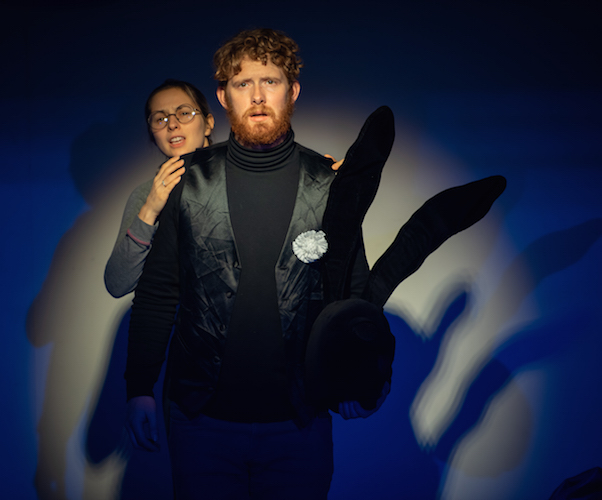Theater Review: “The Miraculous Journey of Edward Tulane” — Rabbit Transit
By Erik Nikander
The company’s staging is dynamic and vivacious, and the unconventional seating arrangements give audience members the chance to place themselves in the center of the action.
The Miraculous Journey of Edward Tulane, an original adaptation of Kate DiCamillo’s children’s book, written and directed by Alexander Huh. Staged by the Arlekin Players at 368 Hillside Avenue, Needham, MA, through March 3.

A scene from the Arlekin Players Theatre staging of “The Miraculous Journey of Edward Tulane.” Photo: courtesy of the Arlekin Players.
Something undeniably comforting happens after you take off your shoes. Maybe because it’s something you do when you get home, ready to unwind from a long day — when the outside world can no longer get to you. Whatever the reason, when I took off my shoes (as requested) and stepped into the seating area of the Arlekin Players Theatre, I felt at ease. At home. In lieu of traditional seats, the sunny yellow floor was covered with small white beds, the outer wall flanked with higher benches. As I settled onto my bench, kids scampered about, many in their pajamas. The atmosphere was set: time to relax and enjoy a bedtime story. The Miraculous Journey of Edward Tulane is a engrossing yarn indeed — though it may not inspire wholly peaceful dreams.
Based on a children’s book by Kate DiCamillo, Edward Tulane is the story of a china rabbit who is passed from owner to owner in a journey that takes him across oceans and into new lands. Arlekin’s original adaptation of the book, directed by Alexander Huh, is a remarkable feat because it compresses the narrative’s epic quest into a show that lasts just under 90 minutes, a short and sweet presentation. The company’s staging is dynamic and vivacious, and the unconventional seating arrangements give audience members the chance to place themselves in the center of the action. The company embraces straightforward storytelling strategies, making for an immersive production.
Nearly everyone in the cast pulls double duty, playing more than one of the strange characters encountered by Edward (including a hobo and his dog, a chef who talks in pure gibberish, and a pair of dolls who watch over a toy store). The acting aims to be larger than life, clear and accentuated enough for the younger audience members to latch on to without being silly enough to put off their parents (and me). Julia Shikh is at once commanding and tender as the Grandmother, and Olga Sokolova gives an endearing and heartbreaking performance, albeit brief, as Sarah Ruth. There are so many strong performances here it is difficult give all the actors the credit they deserve; this is one of the happiest problems an ensemble production can present a critic.
Of course, that’s not to say the show is flawless. In fact, its biggest stumbling block is Edward Tulane himself, played by Eric Andrews. The principal problem is that the production’s approach to the character is, on a visual level, downright terrifying. A towering, statuesque figure dressed in black formal wear — apart from a pair of bright white gloves — he wears an immobile, expressionless black mask with glittering silver eyes. As bunnies go, this one is less Peter Cottontail and more like Frank from Donnie Darko, or perhaps the unsettling characters in David Lynch’s Rabbits short films. To be fair, the kids in the audience didn’t seem to mind the stony-faced creature all that much. But did Huh and costume designer Nastya Bugaeva grasp how austere and nightmarish their vision of Edward is?
Andrews takes his hellish mask off from time to time during the production, and the figure becomes much less intimidating. Unfortunately, regardless of the regrettable costuming, Andrews’s performance as the wayward rabbit feels out of step with the rest of the goings-on. The actor’s flat delivery doesn’t evoke the creature’s loneliness, yearnings, and his growing desire to love and be loved. Andrews’ repressed approach to his role makes for a puzzling contrast with the bright, children’s-theatre enthusiasm proffered by the rest of the cast. Perhaps this is a conscious directorial choice, but to what end? The result is that Edward, the show’s protagonist, doesn’t come off as a compelling or accessible character.
This weakness is a shame because the rest of the production is rollicking and fun. Whether using an outstretched blue sheet as the rippling surface of the ocean, burying Edward in a pile of flying trash bags, or using layers of a costume to portray the night sky, the production’s inventiveness is continually engaging. Even though much of the production is in Russian, (with snippets in English to keep monolingual audience members like me from losing the thread of the plot), the clarity of the acting makes it easy to understand what is going on. At times it might have been preferable for Arlekin to offer some sort of audio translation device, as they had for Dead Man’s Diary — but that system may not have been comfortable for children.
It might not reach the theatrical heights of Arlekin’s other recent productions, but Edward Tulane contains surprises around every corner. The kids who had been running around the theater with abandon before the show began sat quietly once the proceedings began, taking everything in, which by itself speaks volumes about the show’s quality. Parents with kids who are prone to nightmares should be cautious, given that there are visuals here that may be disturbing. Still, for those who are unfazed by things that go bump in the night, The Miraculous Journey of Edward Tulane, despite its limitations, will captivate.
Erik Nikander is a critic, playwright, and filmmaker based in the New England area. His film criticism can be read on Medium and his video reviews on a variety of topics can be viewed on Youtube at EWN Reviews.
